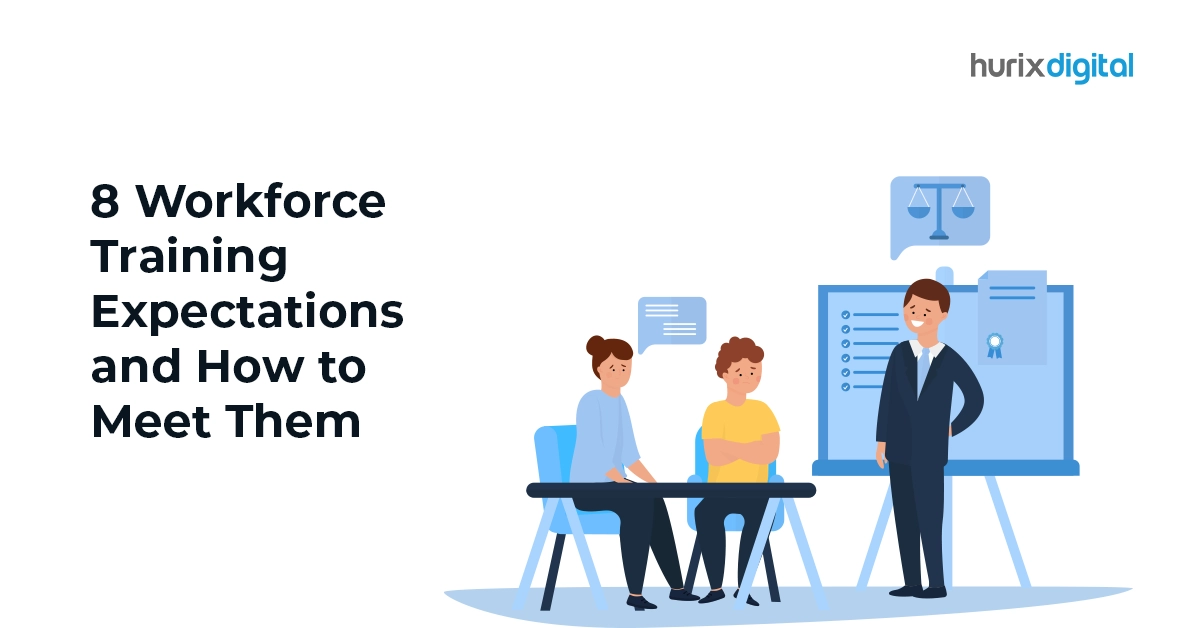
8 Workforce Training Expectations and How to Meet Them
Summary
This post addresses workforce training expectations and how to meet them. Learn strategies for delivering effective training programs that align with modern needs.
Every organization and business model aims to upskill their employees and keep them relevant, equipped, and aligned with their long-term goals. This upskilling process is mainly delivered through workforce training, and the market for this focus is booming at USD 145 billion as of 2022.
While keeping this training to a high standard is crucial, listening to feedback and understanding workforce training expectations is even more critical.
In this piece, we will guide you through a brief on workforce training basics, their main expectations, and ways to meet them effectively. So, let’s start reading!
Table of Contents:
- The Origin Story of Workforce Training Expectations
- Top 8 Workforce Training Expectations
- Nailing These Expectations
- Working Towards Aligned Goals
The Origin Story of Workforce Training Expectations
Workforce training is inherently an organization’s strategic initiative. It focuses on skill development, enhancing subject matter expertise, and ultimately boosting an employee’s performance. All activities, workshops, and pieces of training are synchronized to the organization’s objectives.
In 2024, these targeted workforce training recipients are set in a dynamic environment where their industries and technological advancements evolve constantly. Out of this arises unique needs to thrive in relevance, and amidst competition, employees seek personalized learning modules that also factor in their career aspirations and professional thirst for knowledge.
Through engaging content, interactive approaches, and even gamified assessments, meeting workforce training expectations holds the potential to build an employee’s commitment to the organization while increasing job satisfaction.
Also Read: The Importance of Translation and Localization in Workforce Learning
Top 8 Workforce Training Expectations
Now we’ve understood why and when workforce training expectations arise. To deliver effective and engaging workforce training programs, let’s dive into the details of these expectations and where they come from!
1. Content Relevance
Training modules are usually packed with information and can be harder to grasp when the purpose does not match their needs.
One of the main expectations from these modules is that essential content be relevant to their roles and current trends and challenges. Employees wish to get the most of their time in training so they are given content they can use.
2. Flexibility in Learning
Learners retain less when forced into an inconvenient learning schedule and may face difficulty focusing on the learning content. Employees expect that training programs assigned to them be on their terms of scheduling and delivery methods.
This expectation of flexibility in learning may arise from comfort, schedules in current job profiles, or even the preference for freedom in their learning journey.
3. Engaging Content
This one is universal and applicable to any aspect of life, especially workforce training. Employees expect that their training modules capture and maintain their interest levels.
Retention and motivation levels skyrocket when training material is engaging and interactive. Undoubtedly, engaging content has become a hygiene factor for each employee.
4. Personalized Learning Modules
Just as organizations recognize that every employee is unique, it is also vital to address training content based on this originality and aptitude. A significant workforce expectation is to tailor personalized content to match each employee’s learning style and skill levels.
The expectation of personalized learning modules comes from an employee’s desire to receive training modules that resonate with their strengths, preferences, and aspirations.
5. Accessible Content
A critical expectation is to be able to access training content easily. By accessibility, training content is expected to be adopted onto user-friendly platforms and compatible with different devices. With this, an employee will be confident about participating in training.
Expectations regarding accessibility are crucial for an organization because only if employees can embrace the content can its impact be measured.
6. Robust Feedback
Employees expect to have a robust feedback system while taking on various types of workforce training modules.
This expectation extends to having an active feedback or progress mechanism for their training as well as being able to share feedback on ways to improve the training content itself. Either way, this expectation allows learners to improve faster and voice their opinions.
7. Receiving Rewards and Recognition
It is essential to understand that every employee values being appreciated.
Concerning corporate training solutions that work towards equipping them to perform better, employees expect to be rewarded for their achievements. The expectation of rewards and recognition also comes from showcasing their growing skills.
8. Aligned with Career Goals
For every employee, knowing the impact of workforce training on their professional development is crucial. Employees expect that upskilling for the organization must work in tandem with their long-term career goals.
When workforce trainings are assigned to employees, their motivation is hugely affected by how the module impacts their career goals.
Nailing These Expectations
These top 8 training expectations are very close to heart for every employee. Meeting these expectations may very well decide the impact and involvement of employees toward the organization’s goals.
Here are 5 practices to nail these expectations and garner the strength and performance of the workforce,
1. Focus on UI and UX
In recent years, organizations have begun investing in delivering modules through virtual learning. While this has proven to be quite efficient, these virtual training platforms must be developed with a focus on responsive and intuitive user interfaces (UI) that employees can easily navigate; they are engaged and motivated to learn more.
Remembering that an engaging, compatible, and user-friendly platform helps deliver the right user experience and fosters the right learning environment is crucial.
2. Leverage Technology
With the help of cutting-edge approaches, it becomes infinitely more efficient to deliver immersive and personalized content. Here are some of the latest technologies that meet and exceed employee expectations:
- AI-powered enterprise training modules help implement adaptive and personalized learning.
- Virtual Reality (VR) based learning delivers immersive and experiential learning that tremendously boosts engagement levels and learning speeds.
Employees can also review their progress and get live feedback through these approaches.
3. Regular Feedback Systems
With the help of feedback surveys after each learning module, an organization can receive feedback for continuous improvement. This helps employees know that they have an active hand in workforce training development.
4. Routine Recognition Platforms
By implementing a recognition platform, every employee can access their achievements dashboard and download all necessary certificates. Adding a gamified approach, the platform can also feature a common leadership board where various rewards and prizes are given for each achievement and rank.
This approach helps foster a healthy competitive environment in the workplace and encourages more learning and job satisfaction.
5. Embrace Data Analytics
With all the data that can be derived from training platforms, such as employee performance, progress, feedback, and career goals, an organization can transparently and effectively embrace data analytics with AI. This can help generate content recommendations and roadmaps for employees, enabling them to understand which modules will help achieve their aligned goals.
Also Read: Tech-Forward Training: Integrating Digital Tools in Workforce Learning
Working Towards Aligned Goals
While developing workforce training, it is crucial to understand that upskilling is a two-way street. Both the organization and its employees must be willing to improve, and for that, aligning workforce training expectations like career growth, content accessibility, rewards, and recognition is crucial.
With the help of the steps we have shown you, like an interactive platform, routine feedback systems, and gamified approaches to emphasize rewards, we help you build the ideal approach to meeting workforce expectations with flying colors.
Developing the most effective training module is a challenge we at Hurix Digital can make seamless. So don’t hesitate to reach out and get started on learning modules that boost your organization and employee’s growth! Contact us now!

A highly enthusiastic and motivated sales professional with over twenty five years of experience in solution selling of training-related applications and services. Maintains an assertive and dynamic style that generates results. Ability to establish long-term relationships with clients built on trust, quality of service and strategic vision. Specializes in financial services, higher ed, publishing and government in the areas of learning and development.






